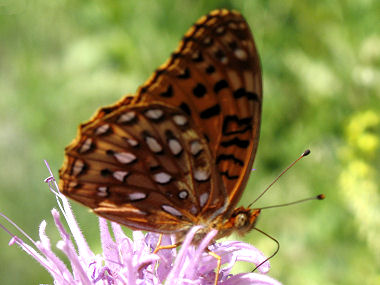Though fritillary butterflies in the genus Speyeria are
difficult to tell apart, the Nokomis Fritillary Butterfly is an orange
butterfly with dark brown spots on the tops of the wings and a pattern of dark
brown crecents and white spots on the underside of the wings. It has a dark
brown to orange body and a wing span up to 3 inches.

|
A population of blue Nokomis Fritilarry
Butterflies was previously found in the Santa Catalina Mountains, but
they have not been seen since 1938 and are assumed to be extinct. The
blue variant may still be found in northern Mexico. |
The Nokomis Fritillary Butterfly is found in eastern Arizona as
well as in CA, NC, UT, CO and NM. The butterflies prefer to live near water in
wet meadows, marshes and in mountains. Females lay
their eggs on the ground in the fall near the butterflies host plant (violets).
The eggs hatch and the larvae hibernate throughout the winter. In the spring
they feed on the leaves of violets before pupating. Butterflies emerge to fly
between August - October. |

